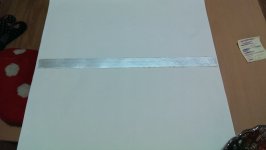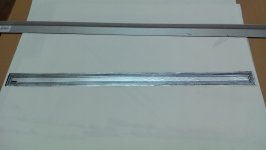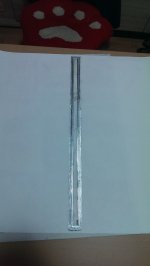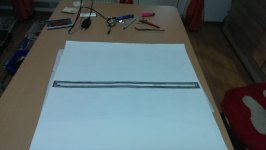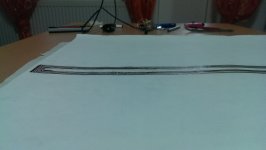Nice orangealpaca !! Very Nice glad you got inspired an above all enjoying yourself!!!!
I have a pause at the moment . Still wanting to try lighter nomex
. Still wanting to try lighter nomex  but prices are outrages or I have to buy huge rolls
but prices are outrages or I have to buy huge rolls  also planning to move and it will need all my attention
also planning to move and it will need all my attention  keep those posts coming !
keep those posts coming !
I have a pause at the moment
Hello, very interesting topic. Guys please share drawings and materials used, can still podskazhiet where to buy all the materials and the flat coil with a magnet. Construction progress will spread here. If you want to make the coil tell me how. I would like to have to make drawings ready for rubonoid members of the forum. Particularly inspired triple rubanoid. Thanks in advance Regards, Vladimir.
everyone having a break ?
Not really.
I'm back home. It seems that the job from Deutchland wasnt for me.. I hope i will go back soon...
Anyway. Monday i started making a coil, manually. 5 turns have almost 11 ohms.
It seems that a very goood way for making the coil is sticking and cutting them directly on the paper.
It takes a painfully wopping 4 and a half hours to cut the coil with razor blades.
Now i know why the inventor of the ruban has used canson paper. First of all it doesnt bend when you use laqueur on it (look at the pics), and second, it is very absorbant wich is not good in terms of humidity resistance.. i have buyed two bottles of special laqueur for paintings wich i hope will saturate the paper making it humidity resistant.
Tomorow i will stick the cilinders together and see what happends. Today i will try to solder the wires to the Al foil.
Cheers
Sergiu
Attachments
Hello, very interesting topic. Guys please share drawings and materials used, can still podskazhiet where to buy all the materials and the flat coil with a magnet. Construction progress will spread here. If you want to make the coil tell me how. I would like to have to make drawings ready for rubonoid members of the forum. Particularly inspired triple rubanoid. Thanks in advance Regards, Vladimir.
Hi biznescenter,
Unfortunately you have to search on this thread.. We have allready posted allmost everything (drawings,schetces and patents) about this speaker.
The conclusion about the coil is that if you want to make a smaller version you can modify a printer and print on Al sticked to foil and then etch or print dirrctly on flexible pcb and then etch. BUT if you want a bigger version you have to make the coil by yourself from Alu foil or find a printer that prints half a meter coil and print on pcb. OR place an order to a pcb factory.
Our colleague here who had made a triple cilinder ruban confirmed even more that a coper winded coil has a limited bandwith. The usage of printed or diy made flat coil is a must.
Cant wait to hear how my ruban sounds.
Cheers
Sergiu
Hi biznescenter,
Unfortunately you have to search on this thread.. We have allready posted allmost everything (drawings,schetces and patents) about this speaker.
The conclusion about the coil is that if you want to make a smaller version you can modify a printer and print on Al sticked to foil and then etch or print dirrctly on flexible pcb and then etch. BUT if you want a bigger version you have to make the coil by yourself from Alu foil or find a printer that prints half a meter coil and print on pcb. OR place an order to a pcb factory.
Our colleague here who had made a triple cilinder ruban confirmed even more that a coper winded coil has a limited bandwith. The usage of printed or diy made flat coil is a must.
Cant wait to hear how my ruban sounds.
Cheers
Sergiu
Hi Sergiu.
Thank you responded. I read the whole topic, but I encountered a language barrier and a figure of speech, especially in the technical part. A lot of things said. I suggest to collect several messages all the experience that each of you have learned with detailed descriptions, photos, projects, drawings, so you can try again. For example, what kind of metal, a thickness which coil accurate dimensions, as it is manufactured, step by step instructions, materials in different countries (as well as printers and paper, foil) are different. Therefore, the exact data needed. Excuse me if I'm not offended Secret. Why is this project attracted me, I've been collecting speakers, mainly of ready-made solutions, all have positive and negative sides. Rubanoid had bad reviews and took in London last year, first place in the sound quality and all were just shocked how he plays. I was touched. Therefore, I decided to try to launch such a project)Do you want me to make a joke, laugh, but I want to learn.Sincerely, Vladimir
Not really.
I'm back home. It seems that the job from Deutchland wasnt for me.. I hope i will go back soon...
Anyway. Monday i started making a coil, manually. 5 turns have almost 11 ohms.
It seems that a very goood way for making the coil is sticking and cutting them directly on the paper.
It takes a painfully wopping 4 and a half hours to cut the coil with razor blades.
Now i know why the inventor of the ruban has used canson paper. First of all it doesnt bend when you use laqueur on it (look at the pics), and second, it is very absorbant wich is not good in terms of humidity resistance.. i have buyed two bottles of special laqueur for paintings wich i hope will saturate the paper making it humidity resistant.
Tomorow i will stick the cilinders together and see what happends. Today i will try to solder the wires to the Al foil.
Cheers
Sergiu
Good job dude !
problem is you cant solder it , even the oil method wont work on thin alu foil
Today i will try to solder the wires to the Al foil.
Cheers
You need special aluminum solder and flux.
http://www.ccis.com/home/hn/
Last edited:
thankyou so much for this thread, especially wrine....
after all your valiant efforts with rubanoids, i was inspired and decided to try a rubanoid spin-off of my own design. due to my twisted style, love of difficult things, and general stupidity, i am attempting to use three lobes, the theory being that the middle one is pistonic. so, you ask? well, ok, 3 is my favourite number....
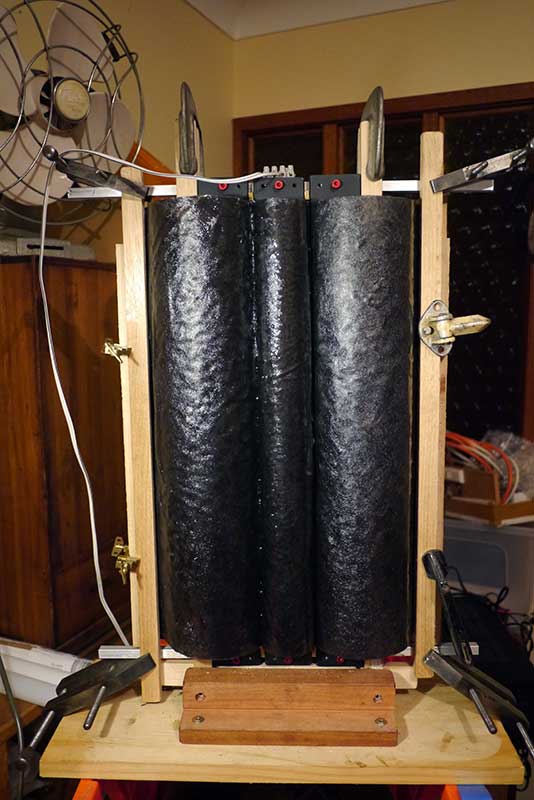
this first test one works well. it makes music.amazing. the fun and wonder of making my own speaker, not just building some boxes for store-bought drivers like usual, is pretty great!
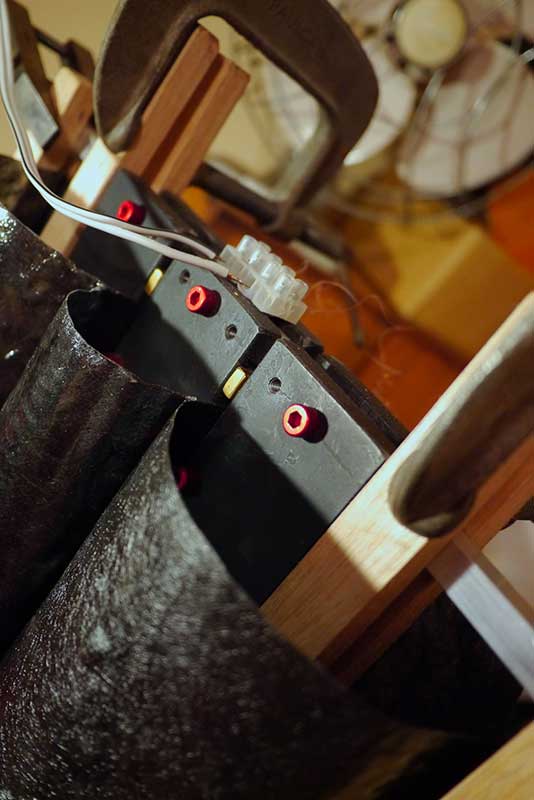
450mm long membranes in carbon fibre and epoxy. N52 magnets - too many for someone who has not much money. hand wound 0.2mm copper wire coils - 33 winds - 16 ohms per side wired in parallel for 8ohm nominal. here is a vimeo video of it playing....
i have two questions as i go further:
- has anyone found any good sources of info regarding membranes, resonances in them, and how to dampen it all, and generally understand what is going on in the vibrating surface?
- where is some good info on measurement of speakers with inexpensive equipment?
next up in this project is making the magnet assembly for the other side, proper measurement, lighter membranes (silk or paper doped, with the coils set in epoxy between the lobes), sourcing copper braided wire for connections to the membrane, and a new system of hanging/tracking to keep it all perfectly in the air gap. surprisingly, i removed my dodgy noisy trial tracking setup because it was not needed - the membrane stays pretty well in the gap once aligned on the sides....until some heavy bass, when it starts to go out of shape and move like a jellyfish....
my initial thoughts on these working prototypes:
- my membrane is carbon fibre with epoxy set over a three-part mould - too heavy. i am thinking of trying doped silk and paper as well. yet the carbon fibre still gets clearly to 13khz with this weight, but drops dead at higher frequencies (or my ears do....)
- they are also very directional at higher frequencies, not so much horizontally (though there is definitely a sweet spot), but vertically - they need to be placed at the right height....
- they have some ringing on certain notes, evident in high pitches of piano and xylophone - certain percussive high tones really can be harsh. need to track down those resonances and trial damping methods in places....
- the bass is very nice - especially drums - they sound like real drums! i would like to chase this bass side of them a little, maybe through a trial with an upsized wave guide (at this size i guess that would make them more like sculpted O.B.'s...?!)
- its all untested as to efficiency or any other hard numbers....
- they are a ridiculous pain to make, especially the composite membranes, and the coils, and the magnet assembly (having three plates makes for more fun and danger....), and the final tweaking to get rid of rattles and hums, not to mention finding bad resonances yet....
thanks to all of those who posted on this - i was inspired, and am now having fun mucking about with possibilities and learning heaps along the way. great stuff! will post a proper build thread when i get a little more done.
what if you would make the middle part as light as possible and the sides damped ? we might achieve higher freq response and a more balanced sound?
indeed doped silk or any other mesh for that mater might work for the high frequency. also in my opinion only front lobbes will give less weird peaks and dalls in the feq response. since there is no out of phase material coming back from the backside.
Thank you very much for the full review! I am very glad that people openly discuss important aspects of building rubanoide. Let's do something interesting, a good proposal to make it 3 parts in rubanoide. Central part made from lightweight material for better high frequencies up to 20k. Why do some rubanoide which the transparent material and voice coil (or is it gain) goes all the way around, explain what it is? More to such review, it would be interesting to create a good sound system!
Vladimir.
Vladimir.
Hello,
I am unproud to say that i ruined almost half the coil (still getting 7.4ohm on the DMM)even with dedicated flux.
Because the surface area is too small and thin, when rubbing with the soldering station iron on it, the trace will snap (if you peel the trace from the paper to solder it) or the paper will get burned (if you solder the Al trace directly onto the paper)...................................
I have setted the soldering station to 420 degree celsius for the first try and the soldering iron gets oxidezed. Tryied different temps and found that a good temp is around 320-340degree celsius.
I think that i am missing something here because I managed to make three solders on the Al coil but now I cant. Its really ******* me off.
Funny is that i have tried the flux on trafo steel sheets and i managed to solder really easy on those.
Wrine, you where right, the oil technique works but only on bigger surfaces where you can conduct the oil in one place preventing it from spreading when soldering.
I will post some pics with the dissastrous results.
Cheers
Sergiu
I am unproud to say that i ruined almost half the coil (still getting 7.4ohm on the DMM)even with dedicated flux.
Because the surface area is too small and thin, when rubbing with the soldering station iron on it, the trace will snap (if you peel the trace from the paper to solder it) or the paper will get burned (if you solder the Al trace directly onto the paper)...................................
I have setted the soldering station to 420 degree celsius for the first try and the soldering iron gets oxidezed. Tryied different temps and found that a good temp is around 320-340degree celsius.
I think that i am missing something here because I managed to make three solders on the Al coil but now I cant. Its really ******* me off.
Funny is that i have tried the flux on trafo steel sheets and i managed to solder really easy on those.
Wrine, you where right, the oil technique works but only on bigger surfaces where you can conduct the oil in one place preventing it from spreading when soldering.
I will post some pics with the dissastrous results.
Cheers
Sergiu
Thank you very much for the full review! I am very glad that people openly discuss important aspects of building rubanoide. Let's do something interesting, a good proposal to make it 3 parts in rubanoide. Central part made from lightweight material for better high frequencies up to 20k. Why do some rubanoide which the transparent material and voice coil (or is it gain) goes all the way around, explain what it is? More to such review, it would be interesting to create a good sound system!
Vladimir.
A really BIG improvement in the hights, as Wrine tested is a very very good contact between the coil and the paper, my friend. If round or square copper wire is used, it is not enought to break the 15khz barrier.
Another aspect wich improves this chapter is lowering the mass of the coil , and the center of the coil (this is what i want to test) and reflect the sound comming from the center with wings as the patent says, BUT they also say that if you lower too much all the membrane mass it will not have such a god dampening and it will resonate very good as Wrine allready tested and measured...
The conclusion is that if you want better specs for this speaker you have to keep in mind what i sayed above, what Wrine tested and what is tested in the other posts and keep a good eye on the patents.
Cheers
Sergiu
Ps: i will post the pics with the ruined coil tomorrow. Now i'm too laisy.
A really BIG improvement in the hights, as Wrine tested is a very very good contact between the coil and the paper, my friend. If round or square copper wire is used, it is not enought to break the 15khz barrier.
Another aspect wich improves this chapter is lowering the mass of the coil , and the center of the coil (this is what i want to test) and reflect the sound comming from the center with wings as the patent says, BUT they also say that if you lower too much all the membrane mass it will not have such a god dampening and it will resonate very good as Wrine allready tested and measured...
The conclusion is that if you want better specs for this speaker you have to keep in mind what i sayed above, what Wrine tested and what is tested in the other posts and keep a good eye on the patents.
Cheers
Sergiu
Ps: i will post the pics with the ruined coil tomorrow. Now i'm too laisy.
well good ur still working on it though. by the way if you want a coil i could make you one to get you started. i could laminated it on Polyester.(0.1mm) but i am limited in width since i only got 30mm copper tape, and mine is limited to a4 paper size as a maximum length. About the weight the coil weight is not an issue, the lower the better. its the paper itself that resonates more when it is of very thin material not really weight but stiffness is the issue when you go lighter paper. trick would be maybe light stiff paper near the center and more heavy well damped the rest of it. so high freq will emit from the middle and the rest does there job in the low end. the only version i had that reached 20kHz was i believe 80 grams paper and coated middle part with PVA glue. but this could well be a measuring fault since the thing has a very weird dispersion. straight in the middle you might end up with crappy high end slightly to the left or right the highs increase. weird unpredictable patern
by the way about stiff and light i looked for foam board 1mm thick this i could squeeze into my magnet gap and is stiff enough to not warp into the gap and is very light. it does exist but i need to buy 50 pieces ..... i dont want 50 pieces
Last edited:
Hi Wrine,
You explained even better than me and i thank you for that. Sorry, english is not my native language..
I would like to take or buy a printed coil from you my friend. I have no probs with the length of the coil because we can split it in two 25cm halves (and then solder the halves together) because the A4 printer format but there is a problem: next month i will go again in Deutchland to search for a job. This will increase my budgets for this project and future ones, and first of all my way of life. So from 10th april i will take another break... Its very hard to find a job there when you are only english speaker and deutch beginer. It seems that almost everyone there knows english but doesnt want people who knows advanced english at work, they want only advanced deutch speaking people wich is abit frustrating... Anyway i wil try harder this time.
Anyway i wil try harder this time. 
I want to try also 3cm wide copper tape but i found that a 30m roll costs here aprox a whopping 110euros wich is really expensive. I dont want to waste money like this, that's why i use Al tape.
Cheers
Sergiu
You explained even better than me and i thank you for that. Sorry, english is not my native language..
I would like to take or buy a printed coil from you my friend. I have no probs with the length of the coil because we can split it in two 25cm halves (and then solder the halves together) because the A4 printer format but there is a problem: next month i will go again in Deutchland to search for a job. This will increase my budgets for this project and future ones, and first of all my way of life. So from 10th april i will take another break... Its very hard to find a job there when you are only english speaker and deutch beginer. It seems that almost everyone there knows english but doesnt want people who knows advanced english at work, they want only advanced deutch speaking people wich is abit frustrating...
 Anyway i wil try harder this time.
Anyway i wil try harder this time. I want to try also 3cm wide copper tape but i found that a 30m roll costs here aprox a whopping 110euros wich is really expensive. I dont want to waste money like this, that's why i use Al tape.
Cheers
Sergiu
Wrine, can you post a picture for the foam pcb? Never heard of this before.
Thanks in advance.
it is foam board. the sandwich of paper/foam/paper. since it has a foam core it is very stiff yet light. it works in DML loudspeakers and since a rubanoide is a bending wave transducer mixed with some pistonic movement it might work. or sound horrible. we just dont know
the 3 cm copper tape is also sold in small rolls as tape against garden snails (the slimy creatures) they dont like to glide onto copper as it seems. so you might find rolsl that are 10 euro for 3 meter, still expensive and way overpriced of course.
I bought my roll on ebay for 17 euro it is 30 meter or something. and they also had 40 and 50mm look for copper tape guitar shielding or something like that.
about the length yes you might use 2 coils but i don't recommend it especially for a trial. since you want to try allot of stuff ,you cant recycle the coils (depending on gluing method) and making one of these coils is still a bit of a PAIN in the *** since my printer has had beter days. it now very often dont want to pickup the paper out of the tray and it has allot of paper jams although nothing is stuck. so i wonder how long he will last. few days back i tried cleaning the nozles then my yellow ran out (somethign i dont use) but it could not complete the cleaning since the ink was empty it then did not want to print black and white anymore. i reset it few times
one other thing if you could find any copper leafs at around 30 micron or thicker that would be a time saver and a money saver. since i could print multiple coils on a substrate and etch them all at once. else i have to print on a piece of paper, then apply copper tape to a piece of polyester then use tape to tape the polyester/copper right on the printed image of the paper, then rough the copper clean it and print for the second time but this time on the copper. then etch it and cut it..... pheeeew
Ooooooh i just found an adres where you can buy only one of these foamboards. but it is in another city where i am working tomorrow.. if i be able to finish early ill get a few (if they have it stocked that is)
http://www.vanderlinde.com/img/products/large/foamboarddun.jpg
http://www.vanderlinde.com/img/products/large/foamboarddun.jpg
Good morning to you all,
Wrine, thank you very much for the invite. When i worked in Aachen-Deutchland i was very close to Netherland indeed.Unfortunatly now i am in Romania and will come back in Deutchland. This time i will go to my aunt wich lives near Regensburg city (and i hope to find a job here), wich is aprox 630km away from the Netherland border..
If i find a job there i will bring my rubanoide and Hiraga amp there and come in a visit to some listening tests in Netherland.
Well the dampening foam looks really good. It may work. It will fit perfectly in a 3mm gap as mine and yours.
I will search again today for copper tape in the garden sales department .
Thanks for the tips. I'll keep things posted as they come.
Cheers
Sergiu
Wrine, thank you very much for the invite. When i worked in Aachen-Deutchland i was very close to Netherland indeed.Unfortunatly now i am in Romania and will come back in Deutchland. This time i will go to my aunt wich lives near Regensburg city (and i hope to find a job here), wich is aprox 630km away from the Netherland border..
If i find a job there i will bring my rubanoide and Hiraga amp there and come in a visit to some listening tests in Netherland.
Well the dampening foam looks really good. It may work. It will fit perfectly in a 3mm gap as mine and yours.
I will search again today for copper tape in the garden sales department .
Thanks for the tips. I'll keep things posted as they come.
Cheers
Sergiu
- Home
- Loudspeakers
- Planars & Exotics
- A DIY Ribbon Speaker of a different Kind
